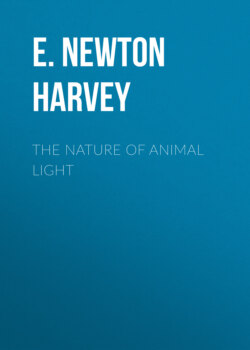Читать книгу The Nature of Animal Light - E. Newton Harvey - Страница 3
На сайте Литреса книга снята с продажи.
PREFACE
ОглавлениеTable of Contents
Bioluminescence, the production of light by animals and plants, has always excited the admiration of the layman and the wonder of the scientist. It is not surprising that an enormous literature dealing with the subject has grown up. A large part of this literature, however, is made up merely of reports that a certain animal is luminous, or records of especially brilliant phosphorescence of the sea. Among those who have inquired somewhat more carefully into the nature and causes of light production may be mentioned the names of Beijerinck, R. Boyle, Dahlgren, Dubois, Ehrenberg, Krukenberg, Mangold, McDermott, Molisch, Panceri, Pflüger, Phipson, Quatrefages, Spallanzani, and Trojan. Several of these men have written comprehensive monographs on the subject.
It is not the purpose of this book to deal with every phase of bioluminescence. Volumes could be written on the evolutionary side of the problem and the structure and uses of luminous organs. These questions can only be touched upon. Neither is it my purpose to discuss the ultimate cause of the light, whether due to vibration of electrons or to other causes. That problem must be left to the physicist, although it is highly probable that a study of animal light will give important information regarding the nature of light in general, and no theory of light can be adequate which fails to take into account the extraordinary powers of luminous animals.
We shall be concerned largely with the physical characteristics of animal light and the chemical processes underlying its production. Great advances have been made since the first early guesses that the light was due to phosphorus and was a kind of oxidation. Although the problem cannot be considered as solved, it has been placed on a sound physico-chemical basis. Some material is oxidized. Exactly what this material is and why light accompanies its oxidation are the two more fundamental problems in the field of Bioluminescence. How far and with what success we have progressed toward a solution of these problems may be seen from a perusal of the following pages.
It gives me pleasure to acknowledge the kindness of Dr. W. E. Forsythe of the Nela Institute, Cleveland, Ohio, in reading and criticizing the manuscript of Chapter III, and of Professor Lyman of Harvard University for a similar review of Chapter II. I am also deeply indebted to my wife for reading the proof and to Dr. Jacques Loeb and Prof. W. J. V. Osterhout for many suggestions throughout the book. My thanks are also due to Prof. C. Ishikawa of the Agricultural College, Imperial University of Tokio, Japan, for his generous assistance in providing Cypridina material. Finally I wish to acknowledge the support of the Carnegie Institution of Washington, through its director of Marine Biology, Dr. Alfred G. Mayor. Without this support much of the work described in this book could not have been accomplished.
E. N. H.
Princeton, N. J.,
October, 1919.
THE NATURE OF ANIMAL LIGHT
